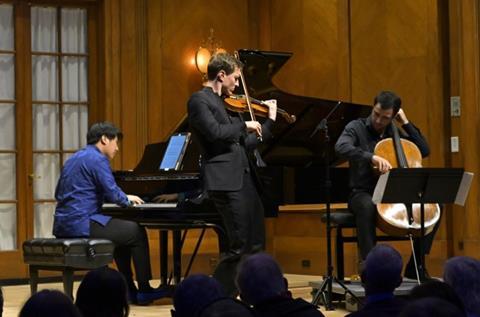Bruce Hodges watches the performance of Auerbach, Weinberg and Dvořák at the Curtis Institute of Music’s Field Concert Hall, PA, US, on 11 January 2023

For a sold-out audience in the recently renovated Field Hall at the Curtis Institute of Music, Trio Zimbalist (all alumni of the school) launched this superb evening with the Piano Trio no.1 (1992–6) by Lera Auerbach, begun when the composer was scarcely 19 years old. Abetted by some arresting effects (such as violinist and cellist playing near the bridge), the musicians plunged into her world with exacting furore. The central movement is perhaps the heart of the piece: marked Andante lamentoso, it packs an emotional wallop not unlike that of Shostakovich. But the mournful mood is completely disrupted by the finale’s furious momentum.
Mieczysław Weinberg wrote his First Piano Trio in 1945, at a similarly early stage in his career and, like the Auerbach, it is full of promise of the wonders to come. It has a blazing intensity that shows why interest in the composer has blossomed over the last decade or so. The three players captured its passion and originality, all the way through to the desolate conclusion, causing the packed hall to burst into cheers and applause.
Review: Efrem Zimbalist: The Auer Legacy
Watch: The way they played: Efrem Zimbalist
Watch: Beethoven’s ‘Kreutzer’ Sonata on film: Efrem Zimbalist
With violinist Josef Špaček (formerly the youngest-ever concertmaster of the Czech Philharmonic Orchestra), cellist Timotheos Gavriilidis-Petrin and pianist George Xiaoyuan Fu all at full tilt, Dvořák’s melody-packed ‘Dumky’ Trio made for a thrilling closing work, with Czech rhythms flying like confetti. As an encore, the three artists offered another dumka by the composer, his Slavonic Dance op.46 no.2, arranged for piano trio, and done with the same assurance that characterised the entire evening.
BRUCE HODGES
The number one source for playing and teaching books, guides, CDs, calendars and back issues of the magazine.
In The Best of Technique you’ll discover the top playing tips of the world’s leading string players and teachers. It’s packed full of exercises for students, plus examples from the standard repertoire to show you how to integrate the technique into your playing.
The Strad’s Masterclass series brings together the finest string players with some of the greatest string works ever written. Always one of our most popular sections, Masterclass has been an invaluable aid to aspiring soloists, chamber musicians and string teachers since the 1990s.
This year’s calendar celebrates the top instruments played by members of the Australian Chamber Orchestra, Melbourne Symphony, Australian String Quartet and some of the country’s greatest soloists.






































No comments yet